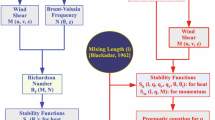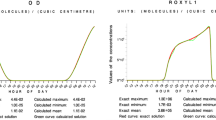Abstract
The radon transport test, which is a widely used test case for atmospheric transport models, is carried out to evaluate the tracer advection schemes in the Grid-Point Atmospheric Model of IAP-LASG (GAMIL). Two of the three available schemes in the model are found to be associated with significant biases in the polar regions and in the upper part of the atmosphere, which implies potentially large errors in the simulation of ozone-like tracers. Theoretical analyses show that inconsistency exists between the advection schemes and the discrete continuity equation in the dynamical core of GAMIL and consequently leads to spurious sources and sinks in the tracer transport equation. The impact of this type of inconsistency is demonstrated by idealized tests and identified as the cause of the aforementioned biases. Other potential effects of this inconsistency are also discussed. Results of this study provide some hints for choosing suitable advection schemes in the GAMIL model. At least for the polar-region-concentrated atmospheric components and the closely correlated chemical species, the Flux-Form Semi-Lagrangian advection scheme produces more reasonable simulations of the large-scale transport processes without significantly increasing the computational expense.
Similar content being viewed by others
References
Chin, M., R. B. Rood, S. J. Lin, J. F. Müller, and A. M. Thompson, 2000: Atmospheric sulfur cycle simulation in the global model GOCART: Model description and global properies. J. Geophys. Res., 105, 24617–24687.
Genthon, C., and A. Armengaud, 1995: Radon 222 as a comparative tracer of transport and mixing in two general circulation models of the atmosphere. J. Geophys. Res., 100(D2), 2849–2866.
Hourdin, F., and A. Armengaud, 1999: The use of finite-volume methods for atmospheric advection of trace species. Part I: Test of various formulations in a general circulation model. Mon. Wea. Rev., 127, 822–837.
Jacob, D. J., and M. J. Prather, 1990: Radon-222 as a test of convective transport in a general circulation model. Tellus, 42B, 118–134.
Jacob, D. J., and Coauthors, 1997: Evaluation and intercomparison of global atmospheric transport models using 222Rn and other short-lived tracers. J. Geophys. Res., 102(D5), 5953–5970.
Lin, S. J., and R. B. Rood, 1996: Multidimensional flux-form semi-Lagrangian transport schemes. Mon. Wea. Rev., 124, 2046–2070.
Lin, S.-J., W. C. Chao, Y. C. Sud, and G. K. Walker, 1994: A class of the van Leer-type transport schemes and its application to the moisture transport in a general circulation model. Mon. Wea. Rev., 122, 1575–1593.
Jöckel, P., R. Kuhlmann, M. G. Lawrence, B. Steil, C. A. M. Brenninkmeijer, P. J. Crutzen, P. J. Rasch, and B. Eaton., 2001: On a fundamental problem in implementing flux-form advection schemes for tracer transport in 3-dimensional general circulation and chemistry transport models. Quart. J. Roy. Meteor. Soc., 127(573), 1035–1052.
Plumb, R. A., and M. K. W. Ko, 1992: Interrelationships between mixing ratios of long-lived stratospheric constituents. J. Geophys. Res., 97, 10145–10156.
Rasch, P. J., and Coauthors, 2000: A comparison of scavenging and deposition processes in global models: Results from the WCRP Cambridge Workshop of 1995. Tellus, 52B, 1025–1056.
Roeckner, E., and Coauthors, 2003: The atmospheric general circulation model ECHAM 5. PART I: Model description. MPI Technical Report 349, Max Planck Institute for Meteorology, Hamburg, Germany, 27–29.
Rotman, D. A., and Coauthors, 2001: Global modeling initiative assessment model: model description, integration and testing of the transport shell. J. Geophys. Res., 106(D2), 1669–1691.
Rotman, D. A., and Coauthors, 2004: Impact, the llnl 3-d global atmospheric chemical transport model for the combined troposphere and stratosphere: Model description and analysis of ozone and other trace gases. J. Geophys. Res., 109, D04303, doi:10.1029/2002JD003155.
Smolarkiewicz, P. K., 1984: A fully multidimensional positive definite advection transport algorithm with small implicit diffusion. Journal Computational Physics, 54, 325–362.
Smolarkiewicz, P. K., and T. L. Clark, 1986: The multidimensional positive definite advection transport algorithm: further development and applications. Journal Computational Physics, 67, 396–438.
Smolarkiewicz, P. K., and W. W. Grabowski, 1990: The multidimensional positive definite advection transport algorithm: Nonoscillatory option. Journal Computational Physics, 86, 355–375.
Smolarkiewicz, P. K., and G. A. Grell, 1992: A class of monotone interpolation schemes. J Comput. Phys., 101, 431–440.
Wan, H., B. Wang, Y. Q. Yu, and R. C. Yu, 2006: Development and validation of the gridpoint atmospheric model of IAP LASG (GAMIL). Technical Report 16, LASG, Institute of Atmospheric Physics, Chinese Academy of Sciences, Beijing, P. R. China, 78pp.
Wang, B., and Z. Z. Ji, 2006: New Numerical Methods in Atmospheric Sciences and Their Applications. Science Press, Beijing, P. R. China, 208pp. (in Chinese)
Wang, B., H. Wan, Z. Z. Ji, X. Zhang, R. C. Yu, Y. Q. Yu, and H. T. Liu, 2004: Design of a new dynamical core for global atmospheric models based on some efficient numerical methods. Science in China(A), 47(Suppl.), 4–21.
Yu, R. C., 1994: A two-step shape-preserving advection scheme. Adv. Atmos. Sci., 11(4), 479–490.
Uppala, S. M., and Coauthors, 2005: The ERA-40 reanalysis. Quart. J. Roy. Meteor. Soc., 131(612), 2961–3012.
Author information
Authors and Affiliations
Corresponding author
Rights and permissions
About this article
Cite this article
Zhang, K., Wan, H., Wang, B. et al. Consistency problem with tracer advection in the Atmospheric Model GAMIL. Adv. Atmos. Sci. 25, 306–318 (2008). https://doi.org/10.1007/s00376-008-0306-z
Received:
Revised:
Published:
Issue Date:
DOI: https://doi.org/10.1007/s00376-008-0306-z




